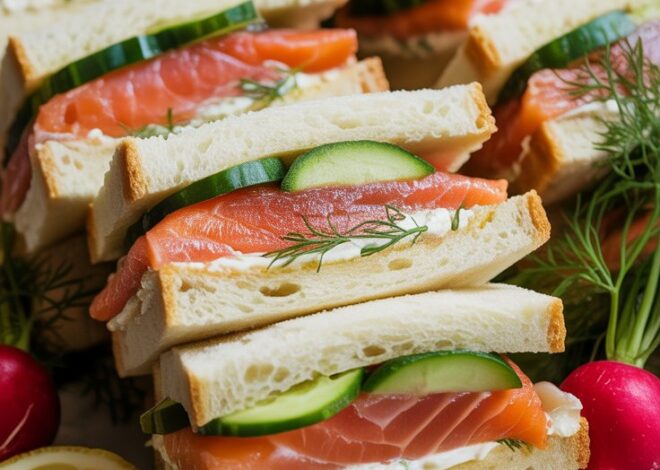
Restaurant-Quality California Roll Sushi Made Simple 2025
Sushi has captured the hearts of food lovers worldwide, offering a delicate balance of flavors, textures, and visual appeal. Among the many types of sushi, the California Roll stands out as a perfect entry point for beginners. This roll, with its creamy avocado, crisp cucumber, and savory imitation crab, wrapped in toasted nori, has become a beloved staple in homes and restaurants alike. Making California Rolls at home is not only a rewarding culinary experience but also a chance to customize flavors and impress family and friends with your sushi skills. In this guide, we will cover everything from selecting ingredients to rolling techniques, variations, and pro tips to create restaurant-quality sushi in your own kitchen.
What Makes California Roll Sushi Special
California Rolls are unique because they combine traditional Japanese sushi techniques with ingredients tailored to Western palates. Unlike raw fish rolls, California Rolls typically feature imitation crab and avocado, making them approachable for beginners. The balance of textures—from the sticky, slightly sweet rice to the crunchy cucumber—creates a satisfying bite that appeals to both kids and adults.
Historically, the California Roll was created in Los Angeles during the 1960s as a way to introduce sushi to Americans. The roll cleverly replaces raw fish with avocado and crab, making sushi accessible while still preserving the essence of Japanese cuisine.
Ingredients You’ll Need
Sushi Rice
The foundation of any sushi roll is perfectly cooked short-grain rice. Short-grain rice has the ideal stickiness for rolling and holds fillings without falling apart. Season it with a mixture of rice vinegar, sugar, and salt for authentic flavor.
Nori Sheets
Nori, the edible seaweed, holds the rice and fillings together. Toasted nori is preferred for home rolls, providing a slightly crisp texture.
Fillings
- Avocado: Ripe yet firm for smooth slicing.
- Cucumber: Seeded and cut into thin strips for crunch.
- Imitation Crab: Log-style crab breaks into perfect strips.
Optional Additions
- Sesame seeds for garnish
- Spicy mayo or sriracha for added flavor
- Tobiko (fish roe) for a visual and flavor boost
Tools and Equipment for Perfect Rolls
To make California Rolls at home, you don’t need professional sushi equipment, but a few tools make the process easier:
- Bamboo Sushi Mat: For rolling the sushi tightly.
- Rice Paddle: To handle sticky rice without crushing it.
- Sharp Knife: Preferably serrated or chef’s knife for clean slices.
- Bowls of Water: To keep hands wet and prevent rice from sticking.
Setting up a clean, organized station with all ingredients and tools within reach will make rolling more efficient and enjoyable.
Preparing Sushi Rice Like a Pro
The rice is the heart of the California Roll, and preparing it correctly ensures your sushi tastes authentic.
Step 1: Rinse and Cook Rice
Rinse the rice under cold water until the water runs clear. This removes excess starch and prevents overly sticky rice. Combine rice with water in a pot, bring to a boil, then cover, reduce heat, and simmer for 15 minutes.
Step 2: Season the Rice
While the rice cooks, whisk together rice vinegar, sugar, and salt until dissolved. Once the rice is done, transfer it to a sheet pan and sprinkle the vinegar mixture evenly. Gently fold the rice using a cutting motion to avoid mashing. Spread rice thinly to cool to room temperature.
Pro Tip: Avoid refrigerating the rice, as this will harden it and make rolling difficult.
Preparing and Cutting Fillings
Avocado
Slice avocado lengthwise, remove the pit, and cut into thin strips. Use a firm but ripe avocado to avoid mushy texture.
Cucumber
Cut cucumber lengthwise, remove seeds, and slice into long thin strips. This ensures the crunchiness is consistent throughout the roll.
Imitation Crab
Break imitation crab into long strips, ideally matching the length of your bamboo mat. You can also add a mix of crab and mayonnaise for a creamy filling.
Optional Proteins: Shrimp, tuna, or tofu can replace crab for variety.
Assembling California Rolls Step by Step
Step 1: Lay Nori and Spread Rice
Place a nori sheet shiny side down on a bamboo mat. Wet your hands to prevent rice from sticking, then spread rice evenly, leaving a 1-inch strip bare at the top.
Step 2: Add Fillings
Lay avocado, crab, and cucumber in a line across the center of the rice. Keep the filling proportionate to avoid overstuffing.
Step 3: Rolling Techniques
Lift the edge of the mat closest to you, fold it over the fillings, and roll tightly into a log shape. Press gently along the roll to seal.
Step 4: Slice the Rolls
Dip a sharp knife in water and slice the roll into 8 even pieces. Wipe the knife between cuts for clean edges. Repeat for remaining sheets.
Pro Tip: Practice makes perfect—don’t worry if your first rolls are not uniform.
Serving Suggestions and Pairings
California Rolls pair beautifully with:
- Soy Sauce for dipping
- Wasabi for a hint of heat
- Pickled Ginger to cleanse the palate
Additional sides:
- Miso Soup: Adds warmth and complements sushi flavors
- Edamame: Lightly salted for a healthy snack
- Seaweed Salad: Adds freshness and visual appeal
Variations and Creative Twists
- Inside-Out Rolls (Uramaki): Rice on the outside, nori inside
- Rainbow Rolls: Top rolls with slices of tuna, salmon, or avocado
- Spicy Crab Rolls: Mix crab with spicy mayo and Sriracha
- Vegetarian Rolls: Replace crab with roasted peppers, carrots, or tofu
- Whole-Grain Twist: Use brown rice or quinoa instead of sushi rice
Storage and Leftover Tips
Sushi is best enjoyed fresh. However, you can store California Rolls in the fridge for up to 24 hours in an airtight container. Cover the cut sides with plastic wrap to prevent drying. Avoid freezing, as it negatively affects rice texture and filling quality.
Pro Tips and Tricks
- Keep your hands wet when handling rice to prevent sticking
- Roll tightly but gently to avoid crushing ingredients
- Use garnishes like sesame seeds or tobiko for restaurant-style presentation
- Practice cutting techniques for neat, uniform slices
Common Mistakes and How to Fix Them
- Rolls Falling Apart: Ensure rice is sticky and roll tightly
- Rice Too Dry: Add a bit more vinegar mixture or handle gently
- Uneven Slices: Use a wet, sharp knife and slice in a single smooth motion
- Overstuffed Rolls: Stick to moderate filling quantities for easier rolling
FAQs About California Roll Sushi
Q: How can I make sushi safe for kids?
A: Use mild fillings like avocado, cucumber, and cooked crab. Avoid raw fish.
Q: What knife is best for cutting sushi?
A: A sharp, serrated knife or a chef’s knife dipped in water between cuts ensures clean edges.
Q: Can I use regular rice instead of sushi rice?
A: Short-grain rice works best. Long-grain rice will not stick properly.
Q: How ripe should the avocado be?
A: Firm yet yielding avocados slice cleanly without turning mushy.
Fun Facts About Sushi
- Sushi originated in Japan as a method to preserve fish in fermented rice.
- California Rolls were invented in Los Angeles in the 1960s to cater to Western tastes.
- Sushi etiquette includes using fingers or chopsticks correctly and enjoying ginger between bites as a palate cleanser.
Health Benefits of Sushi Ingredients
- Avocado: Rich in healthy fats and fiber
- Cucumber: Hydrating and low-calorie
- Imitation Crab: Good source of protein (check labels for additives)
- Seaweed (Nori): Contains iodine, vitamins, and minerals
Conclusion
Mastering California Roll Sushi at home is easier than it seems. With a few simple ingredients, proper techniques, and a bit of practice, anyone can create sushi that tastes like it came from a restaurant. Experiment with fillings, presentation, and flavor combinations to make sushi uniquely yours. Whether for a family dinner, party, or special occasion, homemade California Rolls are fun, delicious, and rewarding.
Embrace the process, enjoy the flavors, and let your creativity guide your sushi-making adventure!


